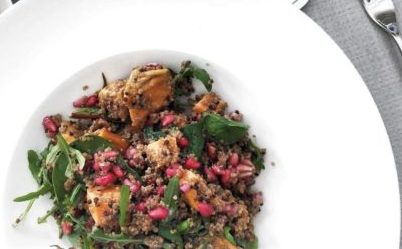Spring and early summer is a splendid time for fresh vegan cooking. Vegaholics everywhere are gorging themselves on asparagus and baby greens. We’re all gleeful gluttons of tiny, fresh peas and artichokes. These are the darlings of the spring vegetable market. But what about the less hyped fruit and vegetable offerings in the farmers markets, green grocers, and produce aisles? Let’s take a look at some novel — and scrumptious — fresh foods available right now.

1. Fennel.
Try this bright, anise-flavored vegetable in thin slices as part of a green salad with a simple lemon vinaigrette, or tossed with mint, or orange, or avocado (or mix and match as you choose) for a fresh, unusual side dish. Fennel is a good source of vitamin C, potassium, and fiber.

2. Morels.
These spongy, earthy mushrooms look more like tall, slender brains on stalks, or tiny bath loofahs. Appearance aside, these are rich, earthy, early spring treats. If you’re very lucky, you’ll find a forager selling them at your farmer’s market. If you can get them, grill them and serve them with a drizzle of extra virgin olive oil on crostini, or toss them with pasta or in a vegan risotto.

3. Cherries.
I think people ruin cherries by adding sugar and contorting them into complicated desserts. Me? I just eat them. I try not to eat entire bowls of cherries in one sitting, but it’s not easy. Cherries are also a glamorous addition to a fresh green salad. Toss them into a bowl of soft Bibb lettuce with some arugula, a few toasted walnuts, and a light dressing of walnut oil and apple cider vinegar.

4. Nettles.
Risk the sting and forage for them on your own — they grow wild wherever they’re least convenient. Or search them out at the farmer’s market. Either way, this nutritional powerhouse makes great soup, pesto, and a potent tea. Stinging nettles are high in potassium, iron, sulfur, vitamin C, vitamin A and several B vitamins. Used for centuries as an herbal remedy, nettles are said to help suppress appetite, settle mood, and detoxify the body. Handle the raw leaves with gloves and don’t worry: once cooked, the jagged, bright green leaves lose their sting and can be used in any recipe calling for sturdy greens.

5. Radishes.
Here’s another old-fashioned favorite, and another entry that needs no recipe. Just trim and scrub small, bright pink radishes and serve them next to a little bowl of sea salt. Dip a radish lightly into the salt and crunch! This is a pungent, healthy snack. You can also chop radishes into vinegary salads with mint, cucumber, and/or ginger. Keep it light and simple and let the powerful, peppery punch of the radish shine through.

6. Fava beans.
These comically big beans, also called broad beans, have a delicate and sweet flavor, but they do take some work. First you must peel them from their pod, and then peel the thick skin off of each individual bean. The second peel is easy, though, if you blanch the beans for 30 seconds and then plunge them into cold water. Fava beans marry well with fresh spring greens, avocados, and asparagus — think of an all-green warm salad or pasta dish (use spinach noodles!) Or serve tossed with fennel and garlic.

7. Rhubarb.
There is absolutely nothing wrong with a strawberry rhubarb pie. There are worse ways to get your dietary fiber and vitamins C, K, calcium, potassium, and manganese. You can also use it in savory dishes. For example, chop and roast rhubarb and red onions and serve with tempeh steaks.

8. Celeriac.
This funky-looking, knobby root vegetable is full of vitamin C, vitamin K, phosphorus, potassium, vitamin B6, magnesium and manganese, and is also a good source of fiber. It tastes similar to celery, but is used in very different ways than its tall, skinny cousin. Mash it, roast it, or even grate it and serve raw in salads or with a spicy faux-rémoulade sauce.

9. Vidalia onions.
Not at all like their harsh yellow onion cousins, and much milder and sweeter than the white onions found year-round in the markets, Vidalias are available in the spring and should be snapped up accordingly. Roast them to sticky, caramelized goodness and try to serve them on a plate rather than standing over the stove and eating them directly from the roasting pan. Or, slice and serve raw on sandwiches or in salads, knowing that your onion breath will not be quite as outrageous as it would be with other onions.

10. Belgian endive.
Learn to spot good ones in the market: they’re pale yellow and white and quite firm, and can easily look like they’re not ripe. Don’t wash them; just wipe them with a damp cloth before cutting. My favorite way to use Belgian endive is to treat it like a “cracker”, using it as a firm, tasty scoop for all kinds of vegetable and bean dips.
These are some of my favorite and most novel choices for spring and early summer eating. Tuck these in among the more typical (but no less fabulous) spring fruits and vegetables for a fresh spark of delicious.

Image via thekitchn.com/ Faith Hopler
Kim Kash has been a writer and editor for over 20 years, many of those with Daedalus Books. The author of the bestselling Ocean City: A Guide to Maryland’s Seaside Resort (Channel Lake, 2009). One of the fitness and nutrition experts at beachbody.com, Kim is also a founder of the Greenbelt Farmers Market near Washington. Beachbody provides effective and popular work out videos and home gym accessories, as well as Shakeology, a nutritionally complete health shake, which is available in vegan chocolate and vegan strawberry tropical. At age 40, Kim and her husband sold everything and moved to the Middle East. Since then, she has traveled to twelve new countries and has taken up sailing, diving, and rock climbing.


